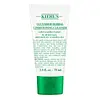What's inside
What's inside
 Key Ingredients
Key Ingredients

No key ingredients
 Benefits
Benefits

 Concerns
Concerns

 Ingredients Side-by-side
Ingredients Side-by-side

Water
Skin ConditioningPropylene Glycol
HumectantGlycerin
HumectantSodium Methyl Cocoyl Taurate
CleansingCoco-Betaine
CleansingSodium Cocoyl Isethionate
CleansingSodium Chloride
MaskingAcrylates/C10-30 Alkyl Acrylate Crosspolymer
Emulsion StabilisingPhenoxyethanol
PreservativePEG-100 Stearate
PPG-5-Ceteth-20
EmulsifyingGlyceryl Stearate
EmollientCoconut Acid
CleansingCaprylyl Glycol
EmollientPEG-55 Propylene Glycol Oleate
Styrene/Acrylates Copolymer
Salicylic Acid
MaskingChlorphenesin
AntimicrobialHydrogenated Coconut Acid
EmollientCucumis Sativus Fruit Extract
EmollientPolyquaternium-53
Coco-Glucoside
CleansingDisodium EDTA
Lavandula Hybrida Oil
EmollientSodium Isethionate
CleansingPEG-30 Dipolyhydroxystearate
EmulsifyingTrideceth-6
EmulsifyingCitrus Medica Peel Oil
Rosmarinus Officinalis Leaf Oil
MaskingBenzoic Acid
MaskingCitric Acid
BufferingSodium Hydroxide
BufferingWater, Propylene Glycol, Glycerin, Sodium Methyl Cocoyl Taurate, Coco-Betaine, Sodium Cocoyl Isethionate, Sodium Chloride, Acrylates/C10-30 Alkyl Acrylate Crosspolymer, Phenoxyethanol, PEG-100 Stearate, PPG-5-Ceteth-20, Glyceryl Stearate, Coconut Acid, Caprylyl Glycol, PEG-55 Propylene Glycol Oleate, Styrene/Acrylates Copolymer, Salicylic Acid, Chlorphenesin, Hydrogenated Coconut Acid, Cucumis Sativus Fruit Extract, Polyquaternium-53, Coco-Glucoside, Disodium EDTA, Lavandula Hybrida Oil, Sodium Isethionate, PEG-30 Dipolyhydroxystearate, Trideceth-6, Citrus Medica Peel Oil, Rosmarinus Officinalis Leaf Oil, Benzoic Acid, Citric Acid, Sodium Hydroxide
Water
Skin ConditioningGlycerin
HumectantMyristic Acid
CleansingStearic Acid
CleansingPEG-32
HumectantPotassium Hydroxide
BufferingPalmitic Acid
EmollientLauric Acid
CleansingCocamidopropyl Betaine
CleansingGlyceryl Stearate
EmollientPEG-100 Stearate
Microcrystalline Cellulose
AbsorbentParfum
MaskingSodium Chloride
MaskingDisodium EDTA
Butylene Glycol
HumectantSodium Benzoate
MaskingMentha Arvensis Leaf Extract
MaskingHydrolyzed Hyaluronic Acid
HumectantPolycaprolactone
StabilisingCI 77891
Cosmetic ColorantPropanediol
Solvent1,2-Hexanediol
Skin ConditioningLactic Acid
BufferingPEG-75
HumectantPolyquaternium-10
Lactic Acid/Glycolic Acid Copolymer
Skin ConditioningEthylhexylglycerin
Skin ConditioningAluminum Hydroxide
EmollientTriethoxycaprylylsilane
Lycium Chinense Fruit Extract
AntioxidantPanthenol
Skin ConditioningPapain
Skin ConditioningRubus Idaeus Fruit Extract
AstringentVaccinium Angustifolium Fruit Extract
Skin ProtectingCoffea Arabica Seed Extract
MaskingSapindus Mukorossi Fruit Extract
Skin ConditioningVaccinium Macrocarpon Fruit Extract
AstringentFragaria Chiloensis Fruit Extract
Skin ConditioningRubus Chamaemorus Seed Extract
Skin ConditioningPhenoxyethanol
PreservativeUndaria Pinnatifida Extract
Skin ConditioningWater, Glycerin, Myristic Acid, Stearic Acid, PEG-32, Potassium Hydroxide, Palmitic Acid, Lauric Acid, Cocamidopropyl Betaine, Glyceryl Stearate, PEG-100 Stearate, Microcrystalline Cellulose, Parfum, Sodium Chloride, Disodium EDTA, Butylene Glycol, Sodium Benzoate, Mentha Arvensis Leaf Extract, Hydrolyzed Hyaluronic Acid, Polycaprolactone, CI 77891, Propanediol, 1,2-Hexanediol, Lactic Acid, PEG-75, Polyquaternium-10, Lactic Acid/Glycolic Acid Copolymer, Ethylhexylglycerin, Aluminum Hydroxide, Triethoxycaprylylsilane, Lycium Chinense Fruit Extract, Panthenol, Papain, Rubus Idaeus Fruit Extract, Vaccinium Angustifolium Fruit Extract, Coffea Arabica Seed Extract, Sapindus Mukorossi Fruit Extract, Vaccinium Macrocarpon Fruit Extract, Fragaria Chiloensis Fruit Extract, Rubus Chamaemorus Seed Extract, Phenoxyethanol, Undaria Pinnatifida Extract
 Reviews
Reviews

Ingredients Explained
These ingredients are found in both products.
Ingredients higher up in an ingredient list are typically present in a larger amount.
Disodium EDTA plays a role in making products more stable by aiding other preservatives.
It is a chelating agent, meaning it neutralizes metal ions that may be found in a product.
Disodium EDTA is a salt of edetic acid and is found to be safe in cosmetic ingredients.
Learn more about Disodium EDTAGlycerin is already naturally found in your skin. It helps moisturize and protect your skin.
A study from 2016 found glycerin to be more effective as a humectant than AHAs and hyaluronic acid.
As a humectant, it helps the skin stay hydrated by pulling moisture to your skin. The low molecular weight of glycerin allows it to pull moisture into the deeper layers of your skin.
Hydrated skin improves your skin barrier; Your skin barrier helps protect against irritants and bacteria.
Glycerin has also been found to have antimicrobial and antiviral properties. Due to these properties, glycerin is often used in wound and burn treatments.
In cosmetics, glycerin is usually derived from plants such as soybean or palm. However, it can also be sourced from animals, such as tallow or animal fat.
This ingredient is organic, colorless, odorless, and non-toxic.
Glycerin is the name for this ingredient in American English. British English uses Glycerol/Glycerine.
Learn more about GlycerinGlyceryl Stearate is a mix of glycerin and stearic acid.
It is used to stabilize the mixing of water and oil ingredients. By preventing these ingredients from separating, it can help elongate shelf life. It can also help thicken the product's texture.
As an emollient, it helps soften skin and supports barrier-replenishing ingredients.
In cosmetics, Glyceryl Stearate is often made from vegetable oils or synthetically produced.
This ingredient may not be fungal-acne safe
Fun fact: The human body also creates Glyceryl Stearate naturally.
Learn more about Glyceryl StearatePeg-100 Stearate is an emollient and emulsifier. As an emollient, it helps keep skin soft by trapping moisture in. On the other hand, emulsifiers help prevent oil and water from separating in a product.
PEGS are a hydrophilic polyether compound . There are 100 ethylene oxide monomers in Peg-100 Stearate. Peg-100 Stearate is polyethylene glycol ester of stearic acid.
Phenoxyethanol is a preservative that has germicide, antimicrobial, and aromatic properties. Studies show that phenoxyethanol can prevent microbial growth. By itself, it has a scent that is similar to that of a rose.
It's often used in formulations along with Caprylyl Glycol to preserve the shelf life of products.
Chances are, you eat sodium chloride every day. Sodium Chloride is also known as table salt.
This ingredient has many purposes in skincare: thickener, emulsifier, and exfoliator.
You'll most likely find this ingredient in cleansers where it is used to create a gel-like texture. As an emulsifier, it also prevents ingredients from separating.
There is much debate on whether this ingredient is comedogenic. The short answer - comedogenic ratings don't tell the whole story. Learn more about comegodenic ratings here.
The concensus about this ingredient causing acne seems to be divided. Research is needed to understand if this ingredient does cause acne.
Scrubs may use salt as the primary exfoliating ingredient.
Learn more about Sodium ChlorideWater. It's the most common cosmetic ingredient of all. You'll usually see it at the top of ingredient lists, meaning that it makes up the largest part of the product.
So why is it so popular? Water most often acts as a solvent - this means that it helps dissolve other ingredients into the formulation.
You'll also recognize water as that liquid we all need to stay alive. If you see this, drink a glass of water. Stay hydrated!
Learn more about Water